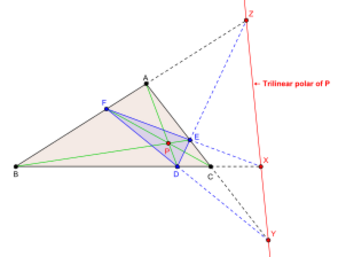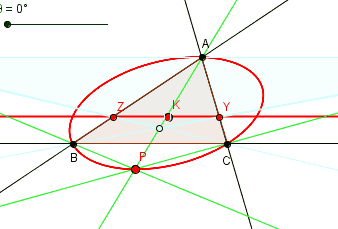Trilinear polarity
In Euclidean geometry, trilinear polarity is a certain correspondence between the points in the plane of a triangle not lying on the sides of the triangle and lines in the plane of the triangle not passing through the vertices of the triangle. "Although it is called a polarity, it is not really a polarity at all, for poles of concurrent lines are not collinear points."[1] It was Jean-Victor Poncelet (1788–1867), a French engineer and mathematician, who introduced the idea of the trilinear polar of a point in 1865.[1][2]
Definitions

Let △ABC be a plane triangle and let P be any point in the plane of the triangle not lying on the sides of the triangle. Briefly, the trilinear polar of P is the axis of perspectivity of the cevian triangle of P and the triangle △ABC.
In detail, let the line AP, BP, CP meet the sidelines BC, CA, AB at D, E, F respectively. Triangle △DEF is the cevian triangle of P with reference to triangle △ABC. Let the pairs of line (BC, EF), (CA, FD), (DE, AB) intersect at X, Y, Z respectively. By Desargues' theorem, the points X, Y, Z are collinear. The line of collinearity is the axis of perspectivity of triangle △ABC and triangle △DEF. The line XYZ is the trilinear polar of the point P.[1]
The points X, Y, Z can also be obtained as the harmonic conjugates of D, E, F with respect to the pairs of points (B, C), (C, A), (A, B) respectively. Poncelet used this idea to define the concept of trilinear polars.[1]
If the line L is the trilinear polar of the point P with respect to the reference triangle △ABC then P is called the trilinear pole of the line L with respect to the reference triangle △ABC.
Trilinear equation
Let the trilinear coordinates of the point P be p : q : r. Then the trilinear equation of the trilinear polar of P is[3]
Construction of the trilinear pole

Let the line L meet the sides BC, CA, AB of triangle △ABC at X, Y, Z respectively. Let the pairs of lines (BY, CZ), (CZ, AX), (AX, BY) meet at U, V, W. Triangles △ABC and △UVW are in perspective and let P be the center of perspectivity. P is the trilinear pole of the line L.
Some trilinear polars
Some of the trilinear polars are well known.[4]
- The trilinear polar of the centroid of triangle △ABC is the line at infinity.
- The trilinear polar of the symmedian point is the Lemoine axis of triangle △ABC.
- The trilinear polar of the orthocenter is the orthic axis.
- Trilinear polars are not defined for points coinciding with the vertices of triangle △ABC.
Poles of pencils of lines

Let P with trilinear coordinates X : Y : Z be the pole of a line passing through a fixed point K with trilinear coordinates x0 : y0 : z0. Equation of the line is
Since this passes through K,
Thus the locus of P is
This is a circumconic of the triangle of reference △ABC. Thus the locus of the poles of a pencil of lines passing through a fixed point K is a circumconic E of the triangle of reference.
It can be shown that K is the perspector[5] of E, namely, where △ABC and the polar triangle[6] with respect to E are perspective. The polar triangle is bounded by the tangents to E at the vertices of △ABC. For example, the Trilinear polar of a point on the circumcircle must pass through its perspector, the Symmedian point X(6).
References
- ↑ 1.0 1.1 1.2 1.3 Coxeter, H.S.M. (1993). The Real Projective Plane. Springer. pp. 102–103. ISBN 9780387978895.
- ↑ Coxeter, H.S.M. (2003). Projective Geometry. Springer. pp. 29. ISBN 9780387406237. https://archive.org/details/projectivegeomet00coxe_193.
- ↑ Weisstein, Eric W.. "Trilinear Polar". MathWorld—A Wolfram Web Resource. http://mathworld.wolfram.com/TrilinearPolar.html. Retrieved 31 July 2012.
- ↑ Weisstein, Eric W.. "Trilinear Pole". MathWorld—A Wolfram Web Resource.. http://mathworld.wolfram.com/TrilinearPole.html. Retrieved 8 August 2012.
- ↑ Weisstein, Eric W.. "Perspector". MathWorld—A Wolfram Web Resource.. https://mathworld.wolfram.com/Perspector.html. Retrieved 3 February 2023.
- ↑ Weisstein, Eric W.. "Polar Triangle". MathWorld—A Wolfram Web Resource.. https://mathworld.wolfram.com/PolarTriangle.html. Retrieved 3 February 2023.
External links
- Geometrikon page : Trilinear polars
- Geometrikon page : Isotomic conjugate of a line
 |

